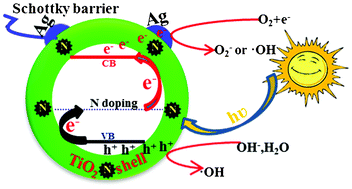It’s now over 30 years since titanium dioxide (TiO2) was first discovered to possess remarkable photocatalytic activity, but interest in this material has not declined. However, despite its high photocatalytic activity, practical applications of TiO2 have been limited due to it’s low quantum efficiency of overall natural sunlight and inferior utilization ratio of visible light.

These particles were stable under high temperature treatment and have a relatively large surface area compared to similar materials from previous studies. The N-doped Ag/TiO2hollow spheres exhibited higher photocatalytic activity for the degradation of dye compounds than pure TiO2 hollow spheres.
Read this article for free until the 7th February 2013!
N-doped Ag/TiO2 hollow spheres for highly efficient photocatalysis under visible-light irradiation, Jianwei Lu, Fengli Su, Zhiqi Huang, Chengxi Zhang, Yuan Liu, Xinbin Ma and Jinlong Gong, RSC Adv., 2013, 3, 720-724










